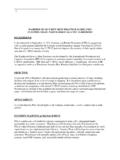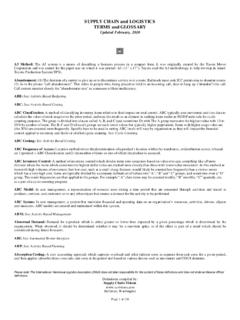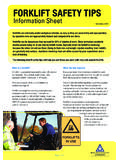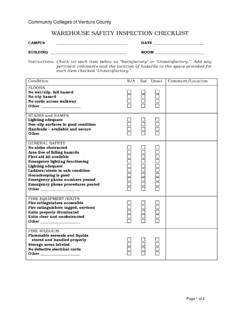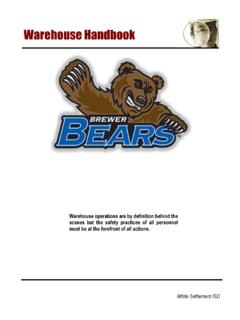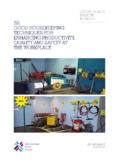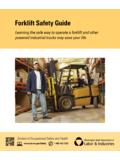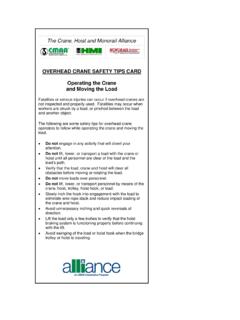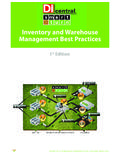Transcription of Monthly Workplace Safety
1 Monthly Workplace Safety and Health Self-Inspection WAREHOUSES FACILITY_____ FOR MONTH OF_____ INSPECTED BY_____ DURATION OF INSPECTION_____ DATE / TIME_____ INSTRUCTIONS: This checklist is intended to help focus attention on the equipment, and commodities at a typical warehouse operation and the most common activities associated with materials handling and storage. It is likely additional areas of concern for Safety and health may exist within a particular warehouse based on the unique materials and activities within. Therefore, the user should add additional check points on this form to address those specific hazards. Place an "X" in the box by each item that best describes its condition. NA = Not Apply warehouse Areas Addressed: A = Acceptable I.
2 general warehouse Areas U = Unacceptable II. Dock Area (Exterior) C = Corrected during inspection III. Dock Areas (Interior) IV. Equipment V. Sanitation VI. Training & general Safety Through OSHA s Alliance Program, this Safety Alert was developed through the OSHA &IWLA Alliance for informational purposes only. It does not necessarily reflect the official views of OSHA or the Department of Labor. I. general warehouse AREASNAAUC1 Are aisles clear and open for material transfers?No product shall be stored in aisles where it blocks equipmentmaneuvering. CORRECTIVE ACTION2 Are floor and rack storage limits properly posted?One sign near the entrance of the warehouse should indicatethe floor rating.
3 All racks should be labeled with load ACTION3 Are rack uprights and beams in good condition?Bent racks and beams must be repaired or racks should be bolted to the ACTION4 Are designated open areas clear of blockage?Such areas include 18 inch perimeters along interior walls as well aselectrical panels and eye wash ACTION5 Are fire extinguishers and overhead fire sprinklers up to date forinspections, in good condition, where they belong and unobstructed?Verify employees have received appropriate training and ACTION6 Are all emergency exits clear of blockage and are the exit signs in good condition?Inspect both inside and outside for blockage of the exit signs should be lit & all emergency lights ACTION7 Pallets must be in good condition. Empties must be stored properly. No broken or protruding wood or nails. No pallets on edge.
4 Avoid storing empty pallets in quantities or densities in excess of fire sprinkler combustible load ACTION8 Are overhead lighting, skylights and roofs in good condition?Check for leaks, broken panels / light bulbs and missing bulb ACTION9 Loose/unboxed materials which might fall from a stack are properly stored by blocking,interlocking or limiting the height of the pile to prevent falling hazards. Insure product stackheights are inforced to prevent container crushing and falling ACTIONPage 2 of 1010 Bags, containers, bundles, etc. are stored in tiers that are stacked, blocked, interlockedand limited in height so that they are stable and secure to prevent sliding or ACTION11 Derail and/or bumper blocks are provided on spur railroad tracks where a rolling carcould contact other cars being worked on or roll out into entrances to buildings, work or traffic ACTION12 Guardrails and/or covers are provided to protect personnel from the hazards of open sides of stairs, platforms, floor openings, floor holes, mezzanines, equipment pits, and other possible fall ACTION13 Elevators and hoists for lifting items are properly used, have adequate / safe clearances, noobstructions, appropriate signals and directional warning signs.
5 Documented annual inspections by licensed inspector are posted on the equipment and on file. CORRECTIVE ACTION14 All hazardous materials' containers are properly labeled, indicating the chemical s identity, the manufacturer s name and address, and appropriate hazard ACTION15 There is a system in place and periodically evaluated to insure each new chemical procured or received is checked to insure it is accompanied by a ACTION16 MSDS book is up to date (annual inventory of chemicals), accessible, and well ACTION17 Employees use proper personal protective equipment when handling chemicals. CORRECTIVE ACTION18 All chemicals are stored according to the manufacturer s recommendations andlocal or national fire codes. ( flammable cabinets, cans, etc.)CORRECTIVE ACTION19 Employees use proper lifting technique for the materials being ACTIONPage 3 of 1020 Products and containers that are most frequently moved by hand are stored at rack heights that minimize bending / stooping or excess reach to pick up or place?
6 CORRECTIVE ACTIONI. general warehouse AREAS TOTALS (Add the number of marks in each category / block above)TOTALS =II. DOCK AREAS+B197 - Exterior21 Are approach roads and staging areas (yard) clear for maneuvering, welldrained, free of potholes and are all signs in place and legible?CORRECTIVE ACTION22Is the approach to the dock well drained and free from potholesor other obstructions?Pay particular attention to snow, ice, storm water and debris build ACTION23 Are dock positions clearly marked with painted lines that the driverscan see to help them spot their trailer accurately?CORRECTIVE ACTION24 Are all exterior lights working properly?This item will need to be inspected during the evening when lightsare ACTION25 Are wheel chocks and/or trailer restraint systems working properly? If trailer restraint systemsare in use remember to inspect for proper locking and indicator light function both inside and outside.
7 Insure tractors are disconnected from ACTION26 Are "attractive nuisances" controlled or removed from around the facility?An attractive nuisance is any feature that might attract children,vandals, vagrants or other undesirable activities ( concrete culverts, stacks of pallets, etc.).CORRECTIVE ACTIONII. DOCK AREAS - Exterior TOTALS (Add the number of marks in each category / block above)TOTALS =Page 4 of 10 III. DOCK AREAS - Interior27 Are visitors and drivers remaining in designated safe areasand walkways?CORRECTIVE ACTION28 Are all interior overhead lights and trailer lights in the dock area operating properly? Test all lights that might be off at time of inspection to be sure they work ACTION29Do dock doors work properly and close completely?Ensure that all doors in use open and close smoothly. Inspectautomatic stops and auto-reversing functions on powered ACTION30 Are dock doors closed when not in use?
8 Closed doors should seal well with the floor and dock leveling ACTION31Is there sufficient room to maneuver materials?Dock area floors should be clean and free of trash, debris,or stored items that block the safe passage of loaded ACTION32 Are there sufficient waste cans for the area and are those cans properly labeled and emptiedon a regular basis? In general are floors, ceilings, and exhaustfans clean and free of cobwebs and dust buildup?CORRECTIVE ACTION33Is there adequate natural or mechanical ventilation to control any potential atmospheric hazards?Where propane powered equipment is in use the ventilation must be tested to rule out excesscarbon dioxide/monoxide An Industrial Hygienist may need to do ACTIONIII. DOCK AREAS - Interior TOTALS (Add the number of marks in each category / block above)TOTALS =IV. EQUIPMENT34 Inspect all ladders and hand tools and indicate here that they arein good condition or in need of any : remove any unsafe equipment from service while awaiting ACTION35 Inspect all ladders and hand tools and indicate here that they arein good condition or in need of any : remove any unsafe equipment from service while awaiting ACTIONPage 5 of 1036 Are forklifts being operated safely and inspected at the start of every shift?
9 Observe powered industrial truck operations and review training certifications to confirm operatorshave been adequately trained and ACTION37Do forklifts have functioning warning devices such as back-up alarms, strobes, or horns?Test equipment as needed, report repairs,and tag out equipment that is unsafe until repairs ACTION38 Are battery charging/changing areas designated for that purpose and contain appropriateemergency flushing facilities( eyewash and shower)?CORRECTIVE ACTION39 Are guards in place for any hazard points on moving equipmentsuch as belt guards on compressors or conveyors?Inspect all powered work tools as well ( cords, insulation, shrouds, casing, guards, etc.).CORRECTIVE ACTION40 Are propane tanks stored correctly and are the tank exchangeand/or tank filling areas properly maintained?Appropriate signs are in place and area is free of ACTION41 Are all fire sprinkler control valves in their open position?
10 Do a visual check to insure the valves are fully ACTION42Do all, powered industrial trucks ( forklifts) meet the design and construction requirements established in American National Standards, Part II ANSI modifications or additions to the lift have been made without manufacturer's written ACTION43 The original capacity, operation and maintenance instruction plates, tags or decals on powered industrial trucks are in place and legible. All authorizedequipment and accessory modifications are also identified on those labels/ ACTION44 Forklifts that are used in hazardous locations ( around flammable materials) are properlymarked / labeled / tagged for the specific hazardous ACTION45 Battery exchange conveyors, overhead hoists or equivalent materials handling equipment are in use where provided and reinstalled batteries are properly positioned and secured while forklift is properly positioned with brakes applied prior to battery ACTIONPage 6 of 1046 Carboy tilters or siphons rated for the specific corrosive material are used for handling electrolytes and are stored in an approproate area ( corrrosvies cabinetor other protected, designated and segregated area).
